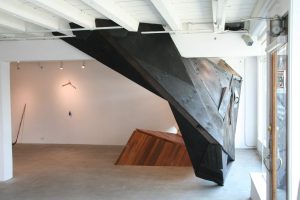
BAF Gallery, Vancouver, 2017
The title riffs on a famous book from the 70’s by JG Ballard called “The Atrocity Exhibition”. There are many interesting things about this book. Highly recommended reading, not just for its seemingly prophetic insights to the digital age. Structurally, its kind of like a kaleidoscope, in that events are repeated from slightly altered points of view. The protagonists name for example, is not quite the same from one chapter to the next, and the same events are referred to in subsequent chapters, again from a shifted perspective. This fragmented kaleidocsopic vision is what inspired the structure of this folded wall construction I have made.
A second thing that is interesting is that over the course of the book, there is an erasure or fracture between what seem to be events playing out in the public realm and events that seem to happen only in a private realm, the protagonists mind. Are the described events memories or echoes of what has already happened? or are these intentions/desires on the part of the protagonist? In this exhibition, the fracturing wall is a shared memory of domestic walls, and also an unfolded/inverted delineating skin between public and private realms.
Also interesting is that the Latin root of Atrocity, refers to fire and seeing. Thus atrocity means “of fiery or threatening appearance”. It also shares a root with atrium, the open main court in a Roman house. I’ve added a playful conditional negation in front of Atrocity, changing it to (n)Atrocity. The exhibition itself isn’t an Atrocity, though indeed the physical construction may be of fiery appearance. Inside the privacy of the home – in our atria – we can become all too oblivious to the real atrocities that arise outside, somewhere else, in the public. Yet, via ubiquitous and portable digital media, such spatial separation is less and less relevant.